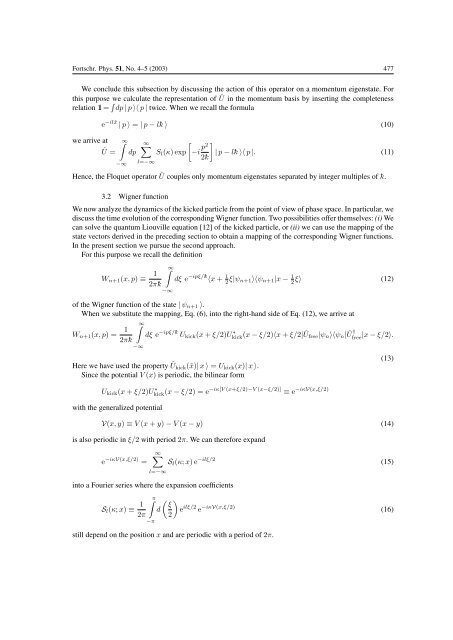Kicked rotor in Wigner phase space - The University of Texas at Austin
Kicked rotor in Wigner phase space - The University of Texas at Austin
Kicked rotor in Wigner phase space - The University of Texas at Austin
Create successful ePaper yourself
Turn your PDF publications into a flip-book with our unique Google optimized e-Paper software.
Fortschr. Phys. 51, No. 4–5 (2003) 477<br />
We conclude this subsection by discuss<strong>in</strong>g the action <strong>of</strong> this oper<strong>at</strong>or on a momentum eigenst<strong>at</strong>e. For<br />
this purposewecalcul<strong>at</strong>etherepresent<strong>at</strong>ion <strong>of</strong> Û <strong>in</strong> the momentum basis by <strong>in</strong>sert<strong>in</strong>g the completeness<br />
rel<strong>at</strong>ion 1l = dp | p 〉〈 p | twice. When we recall the formula<br />
wearrive<strong>at</strong><br />
e −ilˆx | p 〉 = | p − lk - 〉 (10)<br />
Û =<br />
∞<br />
−∞<br />
dp<br />
∞<br />
l=−∞<br />
<br />
Sl(κ) exp −i p2<br />
2k- <br />
| p − lk- 〉〈 p |. (11)<br />
Hence, the Floquet oper<strong>at</strong>or Û couples only momentum eigenst<strong>at</strong>es separ<strong>at</strong>ed by <strong>in</strong>teger multiples <strong>of</strong> k- .<br />
3.2 <strong>Wigner</strong> function<br />
Wenow analyzethedynamics <strong>of</strong> thekicked particlefrom thepo<strong>in</strong>t <strong>of</strong> view <strong>of</strong> <strong>phase</strong><strong>space</strong>. In particular, we<br />
discuss the time evolution <strong>of</strong> the correspond<strong>in</strong>g <strong>Wigner</strong> function. Two possibilities <strong>of</strong>fer themselves: (i) We<br />
can solvethequantum Liouvilleequ<strong>at</strong>ion [12] <strong>of</strong> thekicked particle, or (ii) wecan usethemapp<strong>in</strong>g <strong>of</strong> the<br />
st<strong>at</strong>e vectors derived <strong>in</strong> the preced<strong>in</strong>g section to obta<strong>in</strong> a mapp<strong>in</strong>g <strong>of</strong> the correspond<strong>in</strong>g <strong>Wigner</strong> functions.<br />
In thepresent section wepursuethesecond approach.<br />
For this purposewerecall thedef<strong>in</strong>ition<br />
Wn+1(x, p) ≡ 1<br />
2πk- ∞<br />
−∞<br />
dξ e −ipξ/k- 1 〈x + 2ξ|ψn+1〉〈ψn+1|x − 1<br />
2<br />
ξ〉 (12)<br />
<strong>of</strong> the<strong>Wigner</strong> function <strong>of</strong> thest<strong>at</strong>e| ψn+1 〉.<br />
When wesubstitutethemapp<strong>in</strong>g, Eq. (6), <strong>in</strong>to theright-hand side<strong>of</strong> Eq. (12), wearrive<strong>at</strong><br />
Wn+1(x, p) = 1<br />
2πk- ∞<br />
dξ e −ipξ/k-<br />
Ukick(x + ξ/2)U ∗ †<br />
kick(x − ξ/2)〈x + ξ/2| Ûfree|ψn〉〈ψn| Û free |x − ξ/2〉.<br />
−∞<br />
Herewehaveused theproperty Ûkick(ˆx)| x 〉 = Ukick(x)| x 〉.<br />
S<strong>in</strong>cethepotential V (x) is periodic, the bil<strong>in</strong>ear form<br />
Ukick(x + ξ/2)U ∗ kick(x − ξ/2)=e −iκ[V (x+ξ/2)−V (x−ξ/2)] ≡ e −iκV(x,ξ/2)<br />
with the generalized potential<br />
V(x, y) ≡ V (x + y) − V (x − y) (14)<br />
is also periodic <strong>in</strong> ξ/2 with period 2π. We can therefore expand<br />
e −iκV(x,ξ/2) =<br />
∞<br />
l=−∞<br />
Sl(κ; x)e −ilξ/2<br />
<strong>in</strong>to a Fourier series where the expansion coefficients<br />
Sl(κ; x) ≡ 1<br />
π<br />
d<br />
2π<br />
−π<br />
<br />
ξ<br />
e<br />
2<br />
ilξ/2 e −iκV(x,ξ/2)<br />
still depend on the position x and are periodic with a period <strong>of</strong> 2π.<br />
(13)<br />
(15)<br />
(16)
















